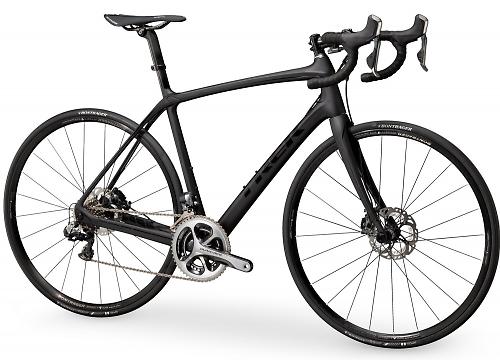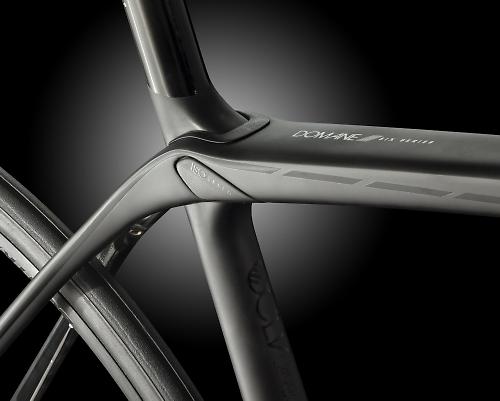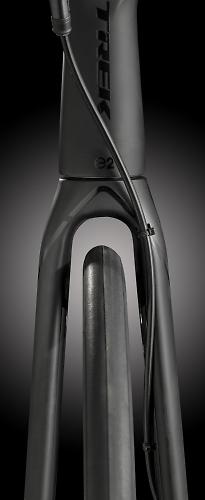- News
- Reviews
- Bikes
- Components
- Bar tape & grips
- Bottom brackets
- Brake & gear cables
- Brake & STI levers
- Brake pads & spares
- Brakes
- Cassettes & freewheels
- Chains
- Chainsets & chainrings
- Derailleurs - front
- Derailleurs - rear
- Forks
- Gear levers & shifters
- Groupsets
- Handlebars & extensions
- Headsets
- Hubs
- Inner tubes
- Pedals
- Quick releases & skewers
- Saddles
- Seatposts
- Stems
- Wheels
- Tyres
- Tubeless valves
- Accessories
- Accessories - misc
- Computer mounts
- Bags
- Bar ends
- Bike bags & cases
- Bottle cages
- Bottles
- Cameras
- Car racks
- Child seats
- Computers
- Glasses
- GPS units
- Helmets
- Lights - front
- Lights - rear
- Lights - sets
- Locks
- Mirrors
- Mudguards
- Racks
- Pumps & CO2 inflators
- Puncture kits
- Reflectives
- Smart watches
- Stands and racks
- Trailers
- Clothing
- Health, fitness and nutrition
- Tools and workshop
- Miscellaneous
- Buyers Guides
- Features
- Forum
- Recommends
- Podcast
TECH NEWS
Trek launch Domane 6.9 Disc (there's a Domane 4.0 Disc too)
Trek have launched a disc-equipped version of the Domane, available at two price points and both borrowing bolt-thru axle technology from their mountain bikes. The Domane 4.0 will cost £1,600 and the Domane 6.9 £6,000, and both will be available this month.

We speculated on the launch of the Domane Disc earlier this year as Keith Bontrager told us he believed Trek would almost certainly launch a disc-equipped road bike in the near future. His prediction has come true, with Trek taking the obvious decision to use their endurance model, the Domane, rather than the racier Madone, for their first disc-equipped road bike. They've already launched a cyclocross bike with disc brakes this year, the Boone CX.
There’s been much debate about wheel axle design on disc-equipped road bikes, and Trek have opted to move away from traditional 9mm quick release axles and adopt bolt-thru technology from their mountain bike range. Called Closed Convert dropouts, they have a 15mm front axle and a 142x12mm rear axle. They can be easily converted to a traditional quick release axle for increased wheel compatibility.

New axles means new wheels, and they’ve developed a new Bontrager Affinity Elite Disc wheelset with bolt-thru hubs. The rims are tubeless-ready - Bontrager have been doing tubeless for a while already. The wheels use interchangeable axle end caps so they can be used on any bike with just a simple change of the end caps required. The wheels have a claimed weight of 1,655g.
An exciting upside of the switch to disc brakes is that Trek says both will happily take wider tyres (though they don’t say how wide) and mudguards, because the removal of the caliper opens up more clearance.

Trek will offer the Domane 6.9 costing £6,000 and the Domane 4.0 at £1,600. Both bikes will be available this month.
“The response we’ve seen from riders about the Domane has been unprecedented and adding a disc brake option further opens the door for riders to expand how and where this bike is ridden,” says Trek Road Bike Brand Manager Michael Mayer.
More details to follow
David worked on the road.cc tech team from 2012-2020. Previously he was editor of Bikemagic.com and before that staff writer at RCUK. He's a seasoned cyclist of all disciplines, from road to mountain biking, touring to cyclo-cross, he only wishes he had time to ride them all. He's mildly competitive, though he'll never admit it, and is a frequent road racer but is too lazy to do really well. He currently resides in the Cotswolds, and you can now find him over on his own YouTube channel David Arthur - Just Ride Bikes.
Latest Comments
- Rendel Harris 1 sec ago
I wondered that too, the inventor eulogises the fact that he can just clip in any bike and be off but if there is no crank sensor on the bike it...
- Rendel Harris 11 min 2 sec ago
Victim blaming at its finest, a driver apparently repeatedly tries to drive into a cyclist to prevent him overtaking and it's the cyclist's fault....
- HLaB 58 min 48 sec ago
I think I'll stick to using old bibs that are a bit too worn to where outside 😂
- chrisonabike 1 hour 8 min ago
Of course ... but the current logic seems to favour "I have bought it so therefore it is my right to use it. If I'm not supposed to it shouldn't...
- BikingBud 1 hour 43 min ago
Paddington Harrow Road crash leaves two seriously injured...
- TheBillder 5 hours 8 min ago
I've had (past tense is deliberate) 3 of these over the past 5 years. I'm back here researching for a replacement as my last one broke last week. I...
- chrisonabike 7 hours 9 min ago
And the next time - plead sympathy for your addiction, caused by trauma from your previous "accident"...
- wtjs 7 hours 13 min ago
Butyric Acid... was the most disgusting thing I have ever smelt in the lab...
- ubercurmudgeon 7 hours 44 min ago
Even a stopped clock, etc, etc...



Add new comment
41 comments
To everyone fretting about a proliferation of thru-axle standards: stop. MTBs have already settled on standards for both the front and rear wheel: 15 mm and 142 mm, respectively (there's 20 mm for the front too, but no one's going to try that on the road). There are plenty of different fasteners (DT Swiss' RWS, Rock Shox's Maxle systems, et al), but from a wheel swap perspective the difference between them is the same as the difference between an external- or internal-cam QR.
The only changes in the standards environment necessary for the smooth operation of neutral service as we know it today would be to specify a rotor size and it's lateral positioning.
I can't see the manufacturers agreeing on any set standards for rotor or axle size any more than they can agree on bottom brackets. It'll take the UCI enforcing the standard and until that happens I wouldn't want to invest in something that could suddenly be made redundant. I'm no Luddite but I really can't see any benefit for discs in road racing any more than I can for deep, aero, 250g carbon rims for mountain biking.
It seems like the road racing issues could be resolved by everyone using the same size rotors and also by agreeing a thru-axle standard at the outset. 11 speed will shortly become the standard and then the only thing the neutral car needs to know is Shimano or Campag
If we look at MTBs for a moment, there are in theory 2 disc brake mount standards. In reality there are millions, no two bikes have the hub/caliper/rotor in the same place, you can't take two wheels and assume that you can fit them.
There is already an issue arising about wide c23mm rims as opposed to traditional c20mm rims where brake clearance is a problem.
If discs are to take off, the UCI will need to state clearly what rotor size and where the disc must sit and also how the wheel fits to the bike.
The insane thing in my eyes, if you want an aggressive disk equipped road bike from Trek, buy the boone and fit slicks.
The head tube on a Domane is in my opinion far too long.
"...happily take wider tyres (though they don’t say how wide) and mudguards, because the removal of the caliper opens up more clearance."
Except it seems to be missing eyelets for guards, so you couldn't attach a decent set. Shame, this would make a great winter bike. Any word on whether they're planning this in the range?
From the photos of the 6.9 i've seen, it looks like the 'vanishing' mudguard mounts are still there. Have a butchers here
http://velonews.competitor.com/2014/05/gallery/gallery-treks-new-domane-...
in pictures 14 and 18. I'd be slightly surprised if they'd removed them from the 4 series certainly, not so the 6 series, but looks like you might be in luck.
Cheers Fukawitribe and well spotted - cheeky little drilling on the back of the seat stays. Can't see anything but according to RCUK, they have "hidden mudguard mounts". Hmmmm. Now to have a little 'chat' with the wife...
Axles are a necessity when equipping wheels with disc brakes. They position the wheel back so that the disc falls exactly between the callipers of the hydraulic brake. With QR, this can be tricky, especially in a hail storm.
Actually this Domane Disk sets the first step towards the next revolution in road cycling. Larger diameter wheels, now that advances in materials and technique have made wheels stiff enough. A slightly larger, broad rimmed wheel would make such bicycles ultra performant on rougher surfaces. MTB's made the step and 26 inch wheels have disappeared from new models in favour of 27.5 and 29 inch. (with the exception of Specialized). The whole transition took less than 2 years, thanks to the massive improvements brought about by the new formats, without ANY downside.
Let the pro peloton get stuck in the past and the rest of us forge forward. Eventually, the pros will catch up, after all that is what they are good at.
You'll find axles are a necessity on any wheel. As for through-axle wheel changes, 5 seconds lost for a racer could spell disaster.
Discs are nice for commuters or wet weather bikes but for performance bikes they don't make sense.
'Performance' meaning 'followed by service car'?
I can see some genuine issues with the use of discs in regulated racing but I'm glad that, for a change, manufacturers have realised that the UCI is a complete irrelevance to most riders.
Besides, I'm pretty sure you could engineer around the front QR issue with either a cowled dropout and close fitting lever/cap - a bit like a thru axle but with a slot or just face the dropout forward so braking pulls the wheel into the slot. Easy.
I don't know if this is meant to be sarcastic, text isn't good at portraying piss-taking. If it is fine, if it isn't you really have bought the marketing crap hook line and sinker!
The sarcastic bit is about mixing an almost century old QR system with modern disk brake technology. I for one gladly exchange 5 sec. lost wheel swapping for the massive improvement of braking power in the wet and the fantastic modulation on long downhills. Besides, once the pros adopt disk brakes (next year?), thru-axles will become more swap friendly. Regarding the standards, the road application of disk brakes is in its infancy, best practices will emerge over time. But the technology, honed over decades in MTB, is already mature enough for the mere mortals (count me in at the time of writing).
Regarding wheelsize, I can only speak of humble personal experience, switching from 26inch to 29inch in XC MTB was a game changer. 26inch promptly vanished from the competitive field. Even for trail and enduro, a new 27.5 inch standard is taking over. 26inch was adopted by chance and was not really thought through. Regarding MTB wheel width, wider rims also allow for less pinched, less "lightbulb" tires which improve grip noticeably. Some road wheel manufacturers looked over the fence and now produce wider rimmed road wheels. Maybe the whole story of 20mm narrow road tires is based on myth rather than fact?
Now take the 700C road standard. It probably evolved as a compromise between lightness and stiffness a generation or two ago (?). But with the massive improvement in materials and manufacturing technology, the standard might have become obsolete. The 29inch MTB wheels on my mountain bike incl. tires are positively huge compared to the wheels on my road bike. Which started me wondering. Any wheel manufacturing enthusiast out there who can move the argument further?
The reason these issues are worth investigating, is that the bicycle is slowly being rediscovered as an ideal mass transportation tool powered by the human heart, and the latter can gratefully use all the improvements we can think of.
Bolt through may be the best engineering solution but I've been using disc brakes with regular old qr axles on my MTBs for over 10 years and never once had a wheel move or pop out. Still, makes sense for the 99% of cyclists who don't have to fret about losing 5 seconds changing a wheel.
My Jamis Nova Pro cyclocross bike rear wheel moves all the time. It's a pain and is enough to stop me buying disc brakes for the foreseeable future until the technology standards bed down
What qr do you have on? I ask because I've found that external cam qrs don't always close tight enough. An internal cam type like Shimano is more reliable.
I'd quite like to see Cancellara faffing about trying to get the bolt thru axle sorted in a hurry after a wheel swap in a hailstorm.
You've never used a bolt-thru axle then?
They're the ones where you unscrew the axle bolt, slide the axle out, put it on the floor, swap wheels, reach out for the axle about to roll down the hillside, slide it back through the frame and hub, try to get the end cap back on without cross threading, then realise the neutral support wheels use hubs a different diameter axle to your frame anyway, if I'm right?
Err, no
In which case, I haven't, no.
Likely to be my next road bike. A mate got a 4 series and it is SUPERB.
I think once the new 105 hydro brake/mech shifter comes out, we'll see a mid priced 5 series bike.
If it rides as good as it looks and I've had a few Treks with the new 105 I'd be putting that high on my list
I was interested until I found out the £1,600 bike has 9 speed sora.....
And echoing the above poster, dodgy, no models in-between, how much would 10 speed tiagra or 105 be?
So you can either spend £1600 or £6000. No choices in between?
Odd.
Internally routing a road bike front brake hydraulic line is difficult. It has to come out of the back of the shifter, into the handle bar, through the stem, into the steerer tube, down the fork and out just above the caliper. All of those parts then become specific to that bike, moving the stem and bleeding becomes a right pain and uses a longer line. Doing it like the Dogma-K where it goes into the top of the fork (where the cable tie post goes) and out at the caliper just looks half done as it doesn't remove the cable clutter from the front end.
My MTB has little black C-clips which hold the brake lines in place, not as cheap as a cable tie and probably not as secure, but re-usable so you can remove the line temporarily while cleaning.
10/10 would bang.
Actually zip ties seem to be more common these days. Check out Cannondale's cross bikes. Their high end model Super x Hi Mod Disc Black inc. has zip ties... Doesn't bother me at all, and a lot easier to work on opposed to internal routing
Zip ties are a big NO NO. On a £6,000 bike... Come on. It reminds me when Specialized use to slap on the Di2 battery with zip ties from the water bottle mount when that first launched. Stop rushing things to market and do them properly.
Pages